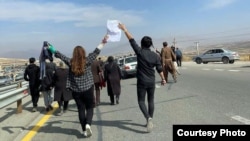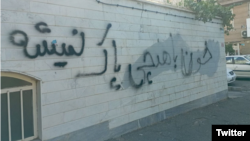
Welcome back to The Farda Briefing, an RFE/RL newsletter that tracks the key issues in Iran and explains why they matter. To subscribe, click here.
I'm RFE/RL correspondent Golnaz Esfandiari. Here's what I’ve been following during the past week and what I’m watching for in the days ahead.
The Big Issue
Iran has accused two female journalists who covered the hospitalization and funeral of 22-year-old Mahsa Amini -- whose death in the custody of Tehran's morality police triggered protests across the country -- of being U.S. spies and the "primary sources of news for foreign media."
The accusations came in a joint statement by the feared intelligence branch of the Islamic Revolutionary Guards Corps (IRGC) and the Intelligence Ministry, which identified the two journalists, Nilufar Hamedi and Elahe Mohammadi, who are being held in Tehran's Evin prison, by their initials. The statement claims the journalists were trained abroad. It also says the protests that have shaken Iran were planned by the CIA along with other foreign intelligence services, including the British and Saudi spy agencies as well as Israel's Mossad.
The statement was met with fear and anger by Iranian journalists and their colleagues, who pushed back against the accusations. Senior editors of Hamedi's Sharq daily and Mohammadi's Hammihan dismissed the charges and said the journalists were only doing their jobs. "Our journalist and our newspaper.....acted within the framework of the journalistic mission," said Mehdi Rahmanian, editor of the reformist Sharq, while Gholamhossein Karbaschi, the editor of Hammihan, said the IRGC-affiliated Fars news agency and other news agencies had similar reports that included more details. More than 500 journalists, photographers, and other media workers demanded the release of their colleagues while calling on officials to allow the free flow of information.
Separately, Tehran's Journalist Association said that based on the statement by the Iranian intelligence agencies, journalism should be banned because "the normal activity of journalists has been cited as evidence of a crime." For its part, the New York-based Committee to Protect Journalists dismissed the charges against the two journalists as "conspiracy theories," adding that it will hold Iranian leaders accountable for any harm done to the journalists.
Why It Matters: The spying accusations against Hamedi and Mohammadi are a major escalation of state pressure on the media, which is already facing a severe crackdown and tough censorship. The spying charges leveled against the two carries the death penalty. According to the CPJ, more than 45 journalists and columnists have been arrested in the current crackdown. The French media watchdog Reporters Without Borders said Iran has become the world's biggest jailer of female journalists in the course of the current crackdown.
Meanwhile, reports have emerged that France-based Iranian journalist Vahid Shamsoddinnezhad, who had traveled to Saghez to cover the aftermath of Amini's death for the European TV channel Arte, has been in jail since September 28.
What's Next: The judiciary has not officially charged the two journalists with spying. The pushback from the Iranian press and journalists and international pressure could be instrumental in clearing the two journalists of the accusations.
Stories You Might Have Missed
- Iranian authorities secretly buried the body of RFE/RL's Radio Farda broadcaster Reza Haghighatnejad at a location near Shiraz after seizing his body upon repatriation to Iran for burial. Haghighatnejad, 45, died of cancer in Berlin on October 17. His body was flown to Iran on October 25. His family was not allowed to see the body or participate in his burial. Radio Farda obtained a video of Haghighatnejad's gravesite, where the anthem of the current mass protests in Iran, Shervin Hajipur's Baraye, was heard in the background. The U.S. State Department has called on Iran to release Haghighatnejad's body and said the episode showed the extent the Iranian government will go to intimidate the press.
- Iran has arrested rapper Toomaj Salehi, who had expressed support for the anti-govenment protests in Iran. Security authorities announced that the rapper was arrested on October 30 while attempting to flee the country. Salehi's uncle denied the claim, saying his nephew was arrested in the southwestern province of Chaharmahal Bakhtiari. Salehi was also detained last year over lyrics he wrote that condemn state repression, the killings of protesters, poverty, and injustice.
What We're Watching
Iran saw a surge in protests last week when thousands of people marked 40 days since the death of Mahsa Amini in state custody. In Amini's hometown of Saghez, a massive crowd gathered at the cemetery where the young woman is buried. Many walked to the cemetery amid reports that authorities had blocked the roads leading to Amini's resting place. Mourners also gathered last week at the grave of 16-year-old Nika Shahkarami near the western city of Khorramabad, 40 days after she was killed in the brutal state crackdown amid reports that security forces had opened fire to disperse mourners while also making arrests.
Why It Matters: The memorial ceremonies for those killed by security forces have energized the protest movement by fueling more anger with state repression. The establishment has responded with force. More protests could erupt as Iranians mourn those killed by security forces.
That’s all from me for now. Don’t forget to send me any questions, comments, or tips that you have.
Until next time,
Golnaz Esfandiari
If you enjoyed this briefing and don't want to miss the next edition, subscribe here. It will be sent to your inbox every Wednesday.




